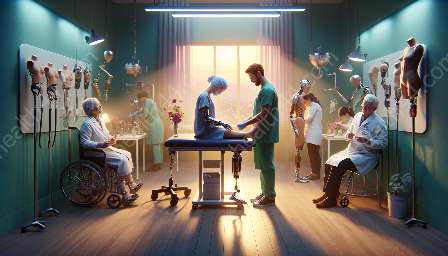For centuries, humans have strived to overcome physical limitations, leading to groundbreaking developments in prosthetic devices and medical equipment. Among these remarkable innovations, hearing aids stand out as a testament to the dedication to enhancing the quality of life for individuals with hearing impairments.
As we delve into the topic cluster about hearing aids, we'll explore their compatibility with prosthetic devices and other medical equipment, shedding light on their history, types, and benefits. Join us on this captivating journey through the world of assistive devices and witness the transformative impact they have on millions of lives around the globe.
The Evolution of Hearing Aids: A Journey Through History
Hearing aids have come a long way since their inception, tracing their roots back to ancient civilizations' rudimentary attempts to amplify sound for individuals with hearing loss. From the ear trumpets of the 17th century to the sophisticated digital devices of the 21st century, the evolution of hearing aids mirrors the progress of medical science and technology.
Notably, the integration of prosthetic devices in the development of hearing aids has opened up new frontiers in auditory rehabilitation. Prosthetic advancements in materials and design have greatly contributed to the comfort and functionality of modern hearing aids, fostering a symbiotic relationship between these two fields of assistive technology.
Types and Features of Hearing Aids for Diverse Needs
Today, a wide array of hearing aids cater to diverse types and degrees of hearing loss, ensuring that individuals can find customized solutions that match their specific needs and preferences. From behind-the-ear (BTE) to completely-in-the-canal (CIC) devices, each type offers unique features that align with users' lifestyles and requirements.
When examining the connection between hearing aids and prosthetic devices, it becomes evident that the convergence of technologies has led to groundbreaking innovations such as bone-anchored hearing aids (BAHA) that incorporate elements of both fields, providing seamless integration for users in need of advanced auditory assistance.
The Benefits of Hearing Aids in Enhancing Quality of Life
For those with hearing impairment, the impact of hearing aids extends far beyond the restoration of sound. These ingenious devices play a pivotal role in facilitating communication, improving cognitive function, and enhancing emotional well-being. Furthermore, the compatibility of hearing aids with other medical equipment and prosthetic devices contributes to a holistic approach to healthcare, promoting overall wellness for individuals with diverse medical needs.
As we navigate the intricate web of assistive technologies, we unearth the interconnectedness of hearing aids with prosthetic devices and medical equipment, underscoring the collaborative efforts to enhance the lives of those with sensory challenges.
In Conclusion: Harmonizing Hearing Aids with Prosthetic Devices and Medical Equipment
In conclusion, the synergy between hearing aids, prosthetic devices, and medical equipment epitomizes humanity's relentless pursuit of innovation and compassion. Through a seamless fusion of technology and empathy, these assistive devices harmoniously coexist to empower individuals with the gift of enhanced perception and connectivity.
By embracing the compatibility of hearing aids with prosthetic devices and other medical equipment, we embrace an inclusive vision of healthcare that uplifts and empowers individuals, reaffirming the boundless potential of human ingenuity in overcoming physical limitations and enhancing lives.


